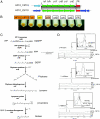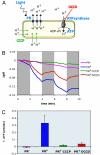Proteorhodopsin photosystem gene expression enables photophosphorylation in a heterologous host
- PMID: 17372221
- PMCID: PMC1838496
- DOI: 10.1073/pnas.0611470104
Proteorhodopsin photosystem gene expression enables photophosphorylation in a heterologous host
Abstract
Proteorhodopsins (PRs) are retinal-containing proteins that catalyze light-activated proton efflux across the cell membrane. These photoproteins are known to be globally distributed in the ocean's photic zone, and they are found in a diverse array of Bacteria and Archaea. Recently, light-enhanced growth rates and yields have been reported in at least one PR-containing marine bacterium, but the physiological basis of light-activated growth stimulation has not yet been determined. To describe more fully PR photosystem genetics and biochemistry, we functionally surveyed a marine picoplankton large-insert genomic library for recombinant clones expressing PR photosystems in vivo. Our screening approach exploited transient increases in vector copy number that significantly enhanced the sensitivity of phenotypic detection. Two genetically distinct recombinants, initially identified by their orange pigmentation, expressed a small cluster of genes encoding a complete PR-based photosystem. Genetic and biochemical analyses of transposon mutants verified the function of gene products in the photopigment and opsin biosynthetic pathways. Heterologous expression of six genes, five encoding photopigment biosynthetic proteins and one encoding a PR, generated a fully functional PR photosystem that enabled photophosphorylation in recombinant Escherichia coli cells exposed to light. Our results demonstrate that a single genetic event can result in the acquisition of phototrophic capabilities in an otherwise chemoorganotrophic microorganism, and they explain in part the ubiquity of PR photosystems among diverse microbial taxa.
Conflict of interest statement
The authors declare no conflict of interest.
Figures



Similar articles
-
Proteorhodopsin lateral gene transfer between marine planktonic Bacteria and Archaea.Nature. 2006 Feb 16;439(7078):847-50. doi: 10.1038/nature04435. Nature. 2006. PMID: 16482157
-
Proteorhodopsin photosystem gene clusters exhibit co-evolutionary trends and shared ancestry among diverse marine microbial phyla.Environ Microbiol. 2007 Apr;9(4):846-58. doi: 10.1111/j.1462-2920.2006.01203.x. Environ Microbiol. 2007. PMID: 17359257
-
Function and regulation of Vibrio campbellii proteorhodopsin: acquired phototrophy in a classical organoheterotroph.PLoS One. 2012;7(6):e38749. doi: 10.1371/journal.pone.0038749. Epub 2012 Jun 7. PLoS One. 2012. PMID: 22741028 Free PMC article.
-
Marine Bacterial and Archaeal Ion-Pumping Rhodopsins: Genetic Diversity, Physiology, and Ecology.Microbiol Mol Biol Rev. 2016 Sep 14;80(4):929-54. doi: 10.1128/MMBR.00003-16. Print 2016 Dec. Microbiol Mol Biol Rev. 2016. PMID: 27630250 Free PMC article. Review.
-
Proteorhodopsins: an array of physiological roles?Nat Rev Microbiol. 2008 Jun;6(6):488-94. doi: 10.1038/nrmicro1893. Epub 2008 May 13. Nat Rev Microbiol. 2008. PMID: 18475306 Review.
Cited by
-
Harnessing the power of microbial autotrophy.Nat Rev Microbiol. 2016 Nov;14(11):692-706. doi: 10.1038/nrmicro.2016.130. Epub 2016 Sep 26. Nat Rev Microbiol. 2016. PMID: 27665719 Review.
-
Metabolic Versatility of the Family Halieaceae Revealed by the Genomics of Novel Cultured Isolates.Microbiol Spectr. 2023 Mar 14;11(2):e0387922. doi: 10.1128/spectrum.03879-22. Online ahead of print. Microbiol Spectr. 2023. PMID: 36916946 Free PMC article.
-
Targeted metagenomic recovery of four divergent viruses reveals shared and distinctive characteristics of giant viruses of marine eukaryotes.Philos Trans R Soc Lond B Biol Sci. 2019 Nov 25;374(1786):20190086. doi: 10.1098/rstb.2019.0086. Epub 2019 Oct 7. Philos Trans R Soc Lond B Biol Sci. 2019. PMID: 31587639 Free PMC article.
-
In vitro gene expression and detergent-free reconstitution of active proteorhodopsin in lipid vesicles.Exp Biol Med (Maywood). 2019 Mar;244(4):314-322. doi: 10.1177/1535370218820290. Epub 2019 Jan 10. Exp Biol Med (Maywood). 2019. PMID: 30630374 Free PMC article.
-
Proteorhodopsin-bearing bacteria in Antarctic sea ice.Appl Environ Microbiol. 2010 Sep;76(17):5918-25. doi: 10.1128/AEM.00562-10. Epub 2010 Jul 2. Appl Environ Microbiol. 2010. PMID: 20601510 Free PMC article.
References
-
- Beja O, Aravind L, Koonin EV, Suzuki MT, Hadd A, Nguyen LP, Jovanovich SB, Gates CM, Feldman RA, Spudich JL, et al. Science. 2000;289:1902–1906. - PubMed
-
- Venter JC, Remington K, Heidelberg JF, Halpern AL, Rusch D, Eisen JA, Wu D, Paulsen I, Nelson KE, Nelson W, et al. Science. 2004;304:66–74. - PubMed
-
- Frigaard N-U, Martinez A, Mincer TJ, DeLong EF. Nature. 2006;439:847–850. - PubMed
Publication types
MeSH terms
Substances
Associated data
- Actions
- Actions
LinkOut - more resources
Full Text Sources
Other Literature Sources
Molecular Biology Databases
Research Materials

